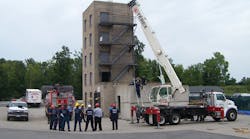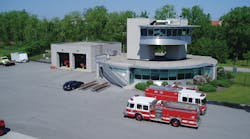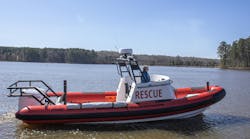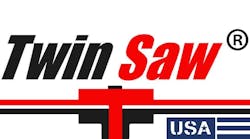This is the final installment of a three-part series about the creation of a state-of-the-art technical rescue training center – the Monroe County, NY, Public Safety Training Facility (PSTF). Part one (June 2011) described how the Monroe County fire service acquired a place to train, assembled an instructional staff and staged equipment. Part two (September 2011) detailed ways in which students put classroom instruction into action during hands-on training.
Once the dust had settled and the last trailer of equipment was on its way home, plans for the future of the training grounds began to develop. Working with the Monroe Community College (MCC) staff, decisions on potential location for the new structure as well as conceptual drawings started to dominate conversations.
The effort was guided by Marc Connolly, emergency services programs manager at MCC. He attended the initial technical rescue school proposal meeting in 2006 and ended the meeting with words of encouragement and promised they would not set the ideas aside to be forgotten. Connolly, with the assistance of other staff and instructors from the training facility, took these ideas and put them in motion.
Like many other projects of this size, many factors were considered before construction began. One primary concern was climate. With cold winters and sometimes extremely hot summer days, an interior training location was determined to be the best option. With that in mind, a 41-by-24-foot building was designed. A high ceiling was also a priority, allowing for two primary features – a four-level void-search simulator and a two-level confined-space simulator.
The void-search simulator has become the facility’s signature feature. Through the combined efforts of the MCC facilities team, a design that includes multiple sliding unions and sleeved support members within each floor was sent out for fabrication. The final product consists of a four-level simulator with three 12-by-10-foot adjustable floors. Each floor can be adjusted to any degree or angle.
Safety was a primary consideration throughout the project. Once the desired location of a floor is obtained, it is secured with a pin system at all four corners to prevent any movement. The floors all have preset cutout locations where students can breach levels as they move through scenarios. To move these large floor sections, electric winches were installed at the top of each support post. This method of lift provides the least amount of stress on the units and in the long run will provide a more economic operation due to minimized maintenance needs. The units are controlled from one location so safety and lockout security are maximized at all times.
The confined-space simulator occupies approximately one-third of the interior space of the building. Multiple access points make changing scenarios easy for the instructional staff. Two horizontal entry points, 18 and 24 inches, allow for direct entry of the simulator or they can be modified with lengths of tubing to vary the operation. From the top level there are two other pre-set openings for vertical operations. One opens directly over the lower level while the second opening has an 18-inch vertical shaft with an opening on the first level that provides additional challenges for students.
The Total Package
With the desire to become a regional training facility for technical rescue, all of the features in the structure were designed to provide positive learning experiences. From the newest student who is just getting into this specialized training arena to the seasoned technician from an urban search and rescue (USAR) team, the site’s adaptability answers each of their learning needs.
Durability and sustainability are two areas where the facility’s fabricators excelled. Each prop, as well as the building itself, was built with top-level materials designed to withstand an ongoing assault by students. To create a practical location for construction of raker shores on the exterior of the building, a wooden framing system was placed over the structure’s steel walls. This provided two benefits – protecting the building itself and a surface where raker shores of various configurations can be assembled.
The primary student entry point into the void simulator is also in this area. By placing the two aspects together, students face the realistic challenge of working in and around other obstacles as they make entry into a structure. Adjacent to this area is one of the many lockout simulators being installed to enhance realism. On the interior of the building a number of other props are available as standalone training areas or they can be included in larger scenarios. A door and window prop aid in the development of exterior shoring skills. Two locations for vertical or dead shores also add to the options for students.
An adjustable header designed into the building provides additional value to the project. First, it lets facilitators create multiple challenges for students. A sloped floor shore is one of the skills that provide a challenge when setting up a course. Having the adjustability of the header lets instructors cover all components of a lesson plan.
Second, and the most cost-effective component of the design, is the ability to raise and lower the header. As the header is lowered the same skill sets can be accomplished using much of the lumber from previous rotations. This allows maximum student involvement in all components of the scenario.
With fixed header props, instructors tend to use the same lengths of lumber over and over to conserve materials and minimize operational costs. This activity limits a student’s ability to practice the specific skills associated with the cutting station.
Keeping the Vision Alive
The commitment of the college to provide the highest level of training options to the community and region is a multi-phase event. With the building in place, planned course offerings will create the full-time equivalents (FTE) needed at all educational facilities. FTEs represent the financial aspect that fuels our educational system. By generating income for the college the vision can be sustained for future generations to enjoy.
Continuing with the focus on team work, the Monroe County Fire Bureau’s (MCFB) training coordinator is working with his counterparts at MCC to develop additional training programs related to technical rescue. Local departments with specialized response capabilities are using the structure for annual drills and in-service proficiency training.
Marketing is another element in the facility’s future success. The more people know of the technical rescue building’s existence and capabilities, the more they will use it. Western New York is an area with limited specialized response capability. For that reason, the MCFB is working to create a local response capability to provide these services to members of its immediate community and be available to surrounding counties.
Through multiple years of grant activities related to USAR operations, the MCFB has acquired many of the specialized pieces of equipment needed for these operations. These additions augment the already extensive cache of equipment within the county. With the facility built and the equipment in place, the training and preparedness levels for the community’s responders will only get better.
Conclusion
Projects of this nature require a high degree of coordination before they can function properly. This facility is a cornerstone of the future success of that vision. This third segment on the creation of a technical rescue facility is the end of the series; however, it is not the end of the project. Each year, other props are recommended and reviewed for feasibility in an effort to enhance the school’s ability to offer students the best level of training possible.
As the training facility grows, I will provide updates on new props and activities taking place on campus. Thank you to all the staff at MCC and the MCFB who assisted in the development of this series.








